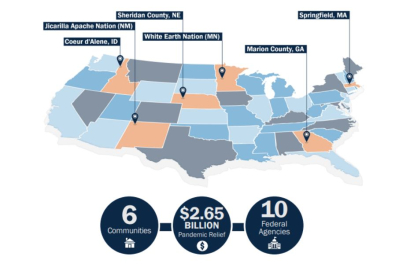Where is the $5 trillion in COVID aid?
The PRAC reports that there are "data gaps" that make it hard to know where the money given by the Biden administration went.

Unsplash
The latest report from the Pandemic Response Accountability Committee (PRAC) reports that there are "data gaps" that "make it difficult" to understand how the more than $5 trillion in aid for to relief the economic damage caused by the COVID-19 pandemic. In addition, after beginning the on-site investigation in six communities, the supervisors found that authorities submitted unreliable data on the use of the funds.
Six communities visited
The PRAC, created by Congress to monitor how the aid was used, visited six randomly selected communities to check how the funds were used. To be representative, two small and medium-sized cities, two rural counties, and two Native American reservations were selected. Finally, Springfield, Mass., Coeur d'Alene, Idaho, Sheridan County, Neb., Marion County, Ga.; the White Earth Nation Reservation of Minnesota and the Jicarilla Apache Nation Reservation in New Mexico were selected.

Map showing the location of the six communities visited by the PRAC.
After reviewing the communities, the PRAC determined that they received some $2.65 billion in aid funds from 10 different federal agencies through approximately 89 pandemic relief programs and sub-programs during the first 18 months of the pandemic, March 2020 to September 2021.
Not even the officials in charge are clear about the recipients and use of COVID aid
In the on-site investigation, the supervisors found difficulties in determining where this money had been invested, both because of "data gaps" and due to the lack of credibility of some of the data provided by those responsible. In addition, the PRAC report reported that not even the officials in charge of managing the relief aid are clear about "the funding recipients and uses."
The difficulty of accessing data is one of the criticisms in the report, which calls on authorities to take steps to make the use of federal funds much more transparent. "Sometimes data was either unreliable or unavailable. In other cases, we had to use data sources that the public can’t access. One partner had to access five federal non-public databases to determine the recipients in a single program. ... There were several programs where we couldn’t determine how much money had been either obligated or spent," the report said.
Missing or insufficient data, duplicate entries...
In this regard, the report noted:
and local data systems, and ultimately we had to contact state and local entities directly
to gain a better understanding and fill data gaps. In the end, complete data was either unavailable or insufficient and did not allow us to definitively identify the total funding provided
to the six communities.
to obtain consistent data or data reports, or to distinguish between unique or duplicative
recipient entries.
RECOMMENDATION





















